Cultures are born, become middle-aged grow old and die, only to be reborn again on a higher level. Will understanding our past help us to make sense of the present and show us a view to the future?
Tonight I will be drawing on the work of the great philosopher and Spiritual Scientist Rudolf Steiner in my exploration of the subject of the seven cultural epochs and their relationship to humanity’s spiritual growth in the past, present and future. At the end I will suggest books for further study.
What are the Seven Cultural Epochs?
To answer this question in Anthroposophical terms it is necessary to gain an understanding of world evolution as taught by Rudolf Steiner. Goethe in his theory of metamorphoses proposed that a seed evolves into a stem, a stem into a leaf, a leaf into a flower and a flower into fruit and finally the fruit drops a seed that begins the whole cycle once again. Rudolf Steiner as a spiritual pupil of Goethe applied this principle to his study of the development of our cosmos, higher beings, the planets, our earth, what lies behind the world beyond sensory existence and individual human beings, animals, plants and minerals. The bulk of this study can be found in Rudolf Steiner’s book Occult Science. In this book, he recounts stages where transmutations have occurred in the evolution of our cosmos. This differs from the plant only in that at each stage of metamorphosis or transmutation there is a further step in development (an evolution – a stage of achieved perfection) so that when there is a repetition of all that has been it occurs at a higher level.
Macrocosm: The Big Picture.
In Occult Science the world will altogether undergo seven planetary stages. We are presently at the fourth stage and still have three to go. I will briefly describe these for the sake of clarity.[1]
The names below are not intended to point to present planets. They are only indications for the sake of the building up of mental pictures. What we see in the sky today are only memories, remnants of the past physical conditions of the earth.
- The First stage was called Old Saturn. Here we are told that human beings first acquired a rudimentary form of the physical body – human beings have this physical body in common with the minerals of the earth and this is what constitutes the bony system. We all know how in our bones we are mineralised.
- The Second stage is called Old Sun where human beings are said to have first acquired an Etheric body or Life body, human beings have this in common with the plant kingdom of the earth and it is this Etheric force that has been integral in the building up of the seven main organs of the body and the blood.
- The Third stage is the called Old Moon where human beings acquired the Astral body or body of feelings and sensations – human beings have this in common with the animal kingdom of the earth. The relevant organs here have to do with the nervous system and the brain.
- The Fourth stage is our present Earth stage where human beings first acquired an Ego, that is, self-awareness or self-consciousness, the ability to realise separateness from the world. This is what Rudolf Steiner calls man's first spiritual member.
- The Fifth stage will occur in what Rudolf Steiner Characterises as Jupiter. This phase of earthly evolution will enable human beings to acquire another spiritual member Manas or Spirit Self. For this to occur there must be a spiritualisation of the Astral body through the workings of the Ego consciousness. This will mean that the ego conscious will work on the purification of thoughts, feelings, desires and passions. This perfected Astral body will lead to a perception of the Astral world in the same way that the Astral or sentient body led to a perception of the physical world. It will be an addition to the perception of the physical world - the consciousness of Angels.
- The Sixth stage will be the Venus stage of world evolution. Here humanity will have perfected the Etheric body through the workings of the Ego and transformed it into a vehicle for another spiritual member, Buddhi or Life Spirit. The habits and moral life will become transformed into all that is good, true and the beautiful and man's perception will extend into the lower regions of Devachan - the Consciousness of Archangels.
- The Seventh stage will be the Vulcan stage where the physical body of human beings will become purified and resound with Light Life and Word. Humanity will be able to attain another spiritual member Spirit Man or Atma. With this new spiritual member humanity will reach with its consciousness all the way to the higher reaches of Devachan - the consciousness of the Archai (the source, origin or root of things that exist).
This is just a quick overview, since each stage also means a spiritualisation for the all the kingdoms of nature, as well as higher beings - they too will change and become further advanced. What was will die away and be reborn again after a period of Pralaya or 'rest' at every stage. This is an oversimplification but to go too deeply into this would be to diverge too far from our topic today.
In the diagram below we can see that Jupiter is a higher repetition of the Moon condition, that Venus is a higher repetition of the Sun condition and that the Vulcan condition will be a higher repetition of the Saturn one. The fourth condition is always the one that can stand by itself without needing a repetition.
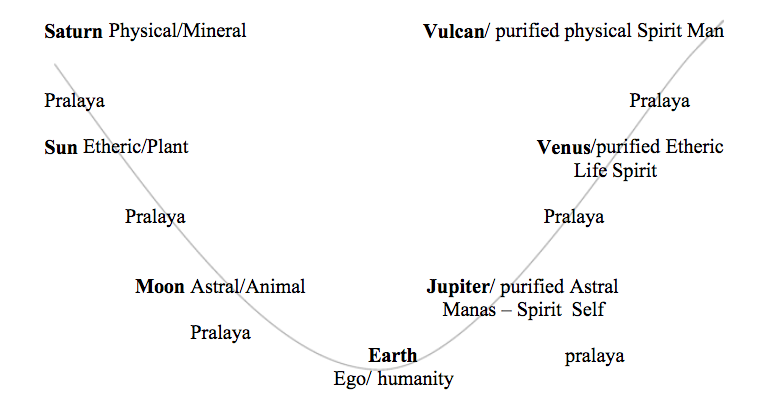
The Earth.
At present humanity is passing through its fourth planetary condition Earth where as we have seen above man is undergoing the development of the Ego. The earthly condition is divided into seven divisions:
- Polarian
- Hyperborean
- Lemurian
- Atlantean
- 5th Post Atlantean Epoch
- 6th Post Atlantean Epoch
- 7th Post Atlantean Epoch
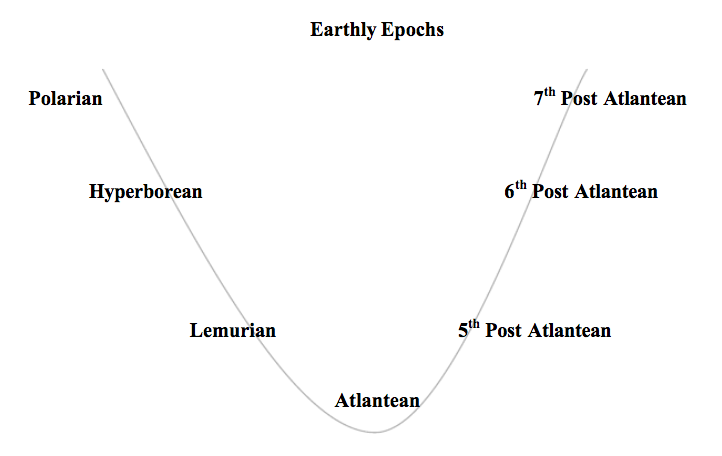
At present we exist in the 5th Post Atlantean Epoch and this epoch is further divided into seven cultural epochs. The cultural epochs are as follows.
- Indian 7227 BC – 5067 BC – Age of Cancer
- Persian 5067 BC – 2970 BC – Age of Gemini
- Egypto Chaldean 2,907 BC – 747 BC – Age of Taurus
- Greco Roman 747 BC – 1413 AD – Age of Aries
- Anglo German 1413 AD – 3573 AD – Age of Pisces
- Russian 3573 AD – 5733 AD – Age of Aquarius
- American 5733 AD – 7893 AD (end of 5th post Atlantean Epoch) – Age of Capricorn
Each epoch lasts for 2160 years and according to Rudolf Steiner has a definite evolutionary task. Each epoch in itself is a form of repetition at a higher stage of the previous earthly ages. The Indian is a repetition of the Polarian which is a repetition of the planetary condition of old Saturn, the Persian the Hyperborean which is a repetition of old Sun, the Egypto Chaldean repeats the Lemurian which is a repetition of old Moon, the Greco Roman the Atlantean a repetition of Earth, the Anglo German repeats once again the Lemurian, the Russian the Hyperborean and the American the Polarian once again repetitions of moon Sun and Saturn respectively.
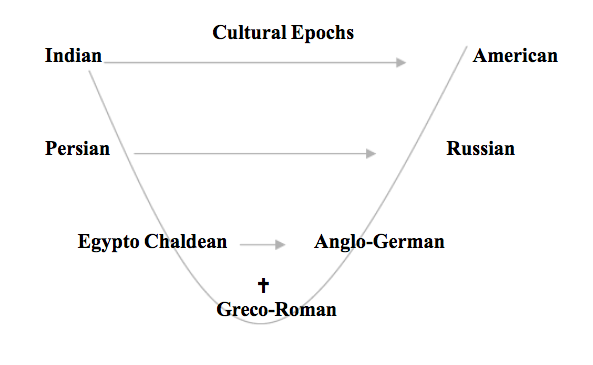
Microcosm: The Human Being.
The human being according to Rudolf Steiner is made up of a triune of members. There are three physical bodies: Physical Etheric Astral. Three soul bodies: Sentient Soul, Intellectual Soul, Consciousness Soul. And three spiritual bodies: Spirit Self, Life Spirit, Spirit Man. We have an Ego or that which gives us individual being or a sense that we are separate from the environment around us and which has worked and continues to work on all our members to perfect them.

Our Ego in so far as it works within our Astral body or our 'nervous system' brings about the development of the Sentient Soul, through which man 'feels and senses' the physical world around him. However man could not retain much of what he felt and observed if those impressions were allowed to remain in the Astral body for they would not be retained for long enough. These impressions would have to sink in deeper into the memory or Life body the Etheric body in order to be contemplated and remembered. When the Ego takes those impressions into the Etheric body it begins to think, it is using the Intellectual soul. When the Ego takes those thoughts and feelings further into the physical body it can be said that in so far as this causes a moral action to occur then the Ego is elaborating what Rudolf Steiner called the Consciousness or Spiritual Soul. Let us take a potted rose as an example: when we look, smell, and touch the rose, the impressions we have received by way of the Astral body are directed to the Ego and it then elaborates the 'Sentient Soul'. When we think about the smell, feel and look of the rose this means that our Ego has taken these impressions down to the Etheric body and we are now elaborating what Steiner called the Intellectual aspect of our soul. If this were all that we did with regards to the rose then it would soon die, but the joy we experience in observing the rose and thinking about it will lead us to look after it, to water and nurture it and place it in a good light. When we are compelled to such a moral action this means that our Ego has taken those impressions and thoughts right down into the physical body and in so doing the Ego is cultivating the 'Consciousness, or Spiritual Soul'. The full development of the Spiritual Soul or Consciousness soul means a transformation for the Astral body. When this transformation has reached a state of perfection through the working of the Ego then the Astral body becomes a spiritual member. Rudolf Steiner calls this first Spiritual Body, the Spirit Self. The Ego (self) indwelling this (spirit) body can now not only observe and sense the rose, think about it and morally act towards it but it can also sense with spiritual senses what lies behind the physical rose – there arises a picture or 'imaginative consciousness' or Imagination.
In the same way that we see with our physical eyes, we begin to see with our Astral or spiritual 'eyes'. In time this Ego residing within this new spiritual body the Spirit Self (Spirit) enters these spiritual impressions into the Etheric body or Life Body (Life) whose eventual perfection results in its transformation into another spiritual body the 'Life Spirit'. With our Life Spirit we can now communicate with the spirit of the rose and this is called Inspiration.
This communication and this 'seeing' compels the Ego residing within the Life Spirit to enter the physical body right down into its bony structure. The perfection of the Physical Body (Man) by this Ego working within the 'Life Spirit' results in the development of the third Spiritual body 'Spirit Man'. Now we are one with the rose and we understand its true essence this is called Intuition.
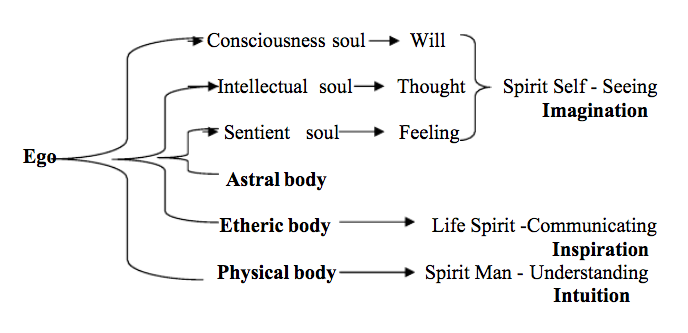
Now that we have a deeper understanding it is possible to move on to the tasks of the Epochs of this present Post Atlantean Age.
According to Rudolf Steiner, we have all incarnated in every epoch. The period between one incarnation and the next is on average somewhere between 1000-1300 years epoch. Every 2,160 (that is during every epoch) human beings incarnate once as a male and once as a female in order to encounter the varied experiences that are necessary for the normal development of the physical, soul and spiritual bodies.
Each Epoch has a task. The Task of the Indian Epoch was to acquire knowledge through the Etheric Body. The task of the Persian Cultural Epoch was to acquire knowledge through the function of the Astral body. In Egypto Chaldean times human beings acquired knowledge through the Sentient soul. In Greco Roman times through the Intellectual Soul. Our age, the Anglo German, in which man will acquire knowledge by way of the Consciousness soul. In the sixth cultural epoch or the Russian epoch it will be the task of human beings to begin to take in knowledge through the Spirit Self. And finally in the seventh and last cultural epoch human beings will begin to acquire knowledge through Life Spirit.
So let us elaborate further these tasks of humanity in the Seven Cultural Epochs.
The Task of the Indian Epoch: Brahma – The acquisition of knowledge through the Etheric Body – The seed.
The term "ancient India" refers here to a time not recorded by human beings. The people now commonly known as Indians belong to a stage of historic evolution developed long afterwards. This is not to say that at this time there was no other civilization it is only that the first post-Atlantean period of the Earth was that time in which the civilization here described as Indian was dominant.
This epoch stands under the sign of Cancer symbolising the end of an old world and the beginning of a new one. The Seven Holy Rishis, the great leaders of the Indian people were the ancestors of the Ancient Atlanteans who migrated from the continent before its downfall. They brought with them a memory of the ancient clairvoyance and could still communicate with the spiritual world. It was the case that at this time if a man wanted to work in the every day world he worked with the organs of his physical senses, but if he wanted to acquire knowledge he had to enter into a different state of consciousness, a state of consciousness acquired through the organs of the Etheric Body. Through his Etheric body the ancient Indian could experience the spiritual world in the same way he could experience the physical world through his physical body. This gave him a feeling of spiritual 'oneness' with higher beings a state that resembled the state of 'oneness' of the first earthly age and the first planetary condition. This spirit of 'oneness' was summed up by the Indian as Brahma[2]. The Indian felt that the world he could see with his Etheric organs in its unity was his primeval home. In contrast the physical world was to the ancient Indian a fallacy of his perception an illusion. This led to the doctrine of Maya. The Indian person had no interest in the Earth except as a veil (Maya) of the supersensible[3], and sought to free himself from its bondage.
A faint echo of the spiritual wisdom of the Indians is contained in the Vedas, the Ramayana and the Bhagavad-Gita wherein there is an undertone of the longing for what the Indian man has lost; we can hear it even today in traditional Indian music. This was the beginning of the withdrawal of the spirit from humanity and was necessary so that the human being could develop a means to raise himself through his own efforts to the Gods.
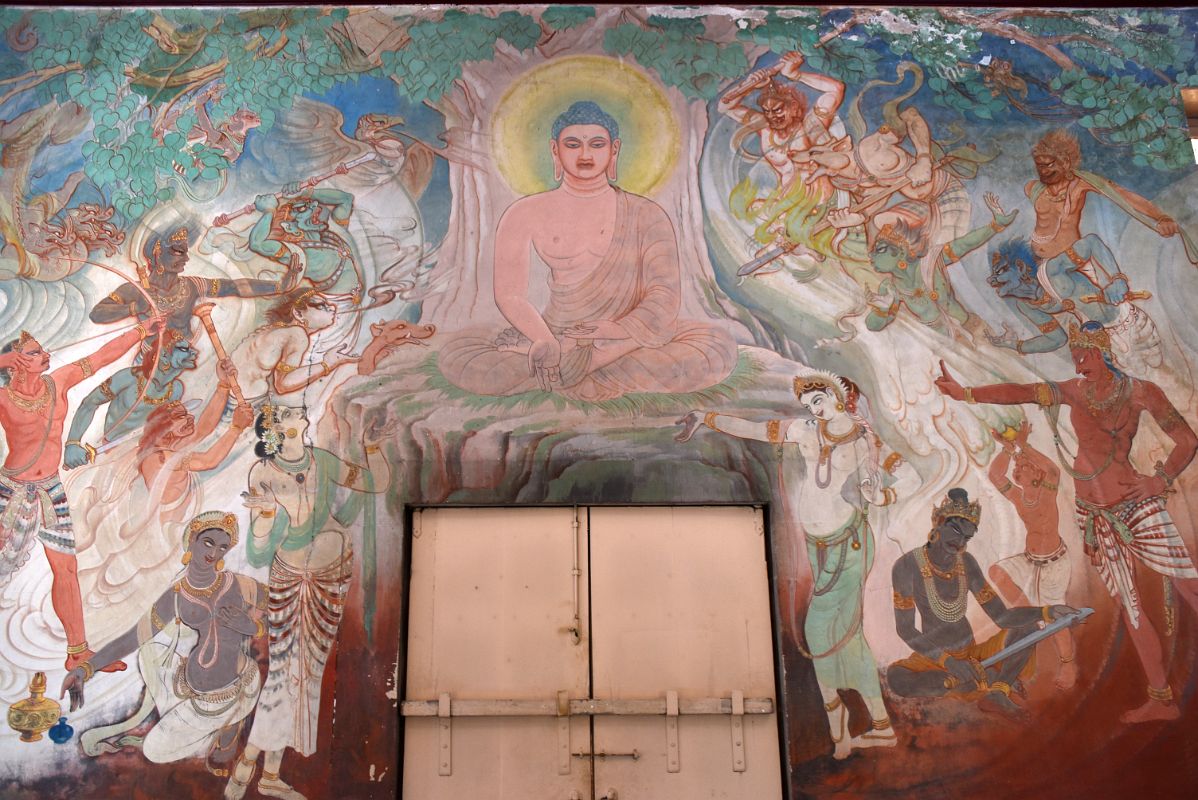
If we look at this early picture of the Buddha we can sense immediately the disconnection from the outside world of Maya. The Buddha's eyes are closed and he pays little notice to the devils that are all around him desiring to tempt him with the material senses.
In another painting from a Sibi Temple we see the demon king Ravana with his twenty arms and hands and ten heads. We see how the Indian could plainly discern the spirit of deception – having many faces and many hands with which to accomplish evil. Take note that they look much like wings. The legs are solid and strong and resemble those of an animal showing his animal-like will a fallen decadent will. Note also that the eyes open gradually from right to left. This signifies a growing openness to the material world and indicates a nature that is not so holy.

The Task of the Persian Epoch: Ormuz and Ahriman - The battle of Light and Darkness – the Acquisition of knowledge through the Astral Body – The Root.
The Persian Epoch stands under the sign of Gemini and it is interesting to note that the ancient Persian did not long for unity and developed instead a sense for duality; he could look out to the world of the stars and see it in all its clarity and brilliance, he was at once with the stars he belonged to them; while at the same time the power to look outwards to the world through the vehicle of the Astral body gradually unfolded. The two aspects of 'seeing' coexisted together. Unlike the ancient Indian the Persian found that the world of Cosmic space held the same interest as the physical world.
The principles of light and darkness were observed by the great initiate Zarathustra as the opposition between two beings, one of which was personified in the sun and the other in the moon. Ahura Mazdao or Ormuzd, the Light-aura, is the being whom the Persians worshiped as the highest god and Ahriman the evil spirit who represented all the beings who belonged to earth-plus-moon. We can see how this Epoch is a further repetition of the Sun planetary condition and also the Hyperborean age when the Sun broke away from the earth so that there were now two bodies a Moon –Earth and an external Sun.
It is comprehensible then that the ancient Persian used neither temples, altars, nor statues in their worship, but performed their sacrifices on the tops of mountains from whence they could gaze out at both the outer world of nature and the world of the stars (spirit). We can hear this ability to fuse sense impressions with spiritual understanding in the many hymns and sacrificial mantras of the Zend Avesta.
'We sacrifice to the undying, shining, swift-horsed Sun. When the light of the sun waxes warmer, when the brightness of the sun waxes warmer, then stand up the heavenly Yazatas, by hundreds and thousands, they gather together its glory, they make its increase of the worlds of holiness, for the increase of the creatures of holiness, for the increase of the undying shinning, swift horsed sun.'
A Mazdean Sacrifice to the Sun (Khorshed Yasht, 1-5)
In art we see a growing ability to balance spirit and mater. The winged body of a lion with the head of a man above the winded disc of the sun from the Palace of Darius at Susa.

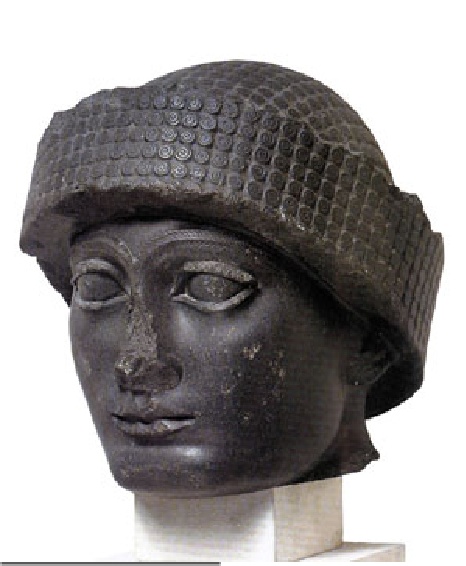
The above Persian head shows a further descent towards the world of matter. The head is beautiful but the face lacks personality. It is blank and lifeless.
The Task of the Third Cultural Epoch - Egypto Chaldean – Osiris, Isis, Horus – The Triniy of the Gods - Acquisition of knowledge through the Sentient Soul – The Stem.
The Egypto/Chaldean Epoch stands under the sign of the Bull or Taurus (we see this reflected in the Mithras mysteries) and its task was in giving humanity opportunities for acquiring knowledge through the Sentient soul. This means that the human being of that time could take the impressions received from the outer world and could make them more inwardly felt. Similarly, human beings could also bring their experiences of the spiritual worlds to intimate consciousness within. The Sentient or Feeling soul then did not experience merely light and darkness but something of the element of life that is present in sympathies and antipathies.
From their Temples the Egyptians could observe the world of stars and find their relationship to the physical world (Geometry, Architecture, Mathematics)[4]. And it was also in a Temple or pyramid that the acolyte or student of the mysteries would undergo an elaborate initiation rite called the "Temple Sleep" in order to see into the worlds of Spirit.
From this inward and outward observation there arose the veneration of a divine trinity, Osiris, Isis and Horus. We can see how this mirrors the Moon Planetary stage and the Lemurian age insofar as it was during the Moon stage firstly and the Lemurian age finally that the physical Moon and all beings related to it made their break from the earth leaving now three bodies to be observed by the human being - Sun, Moon and Earth - Osiris being the representative of the Sun the divine source of Life, the fertiliser of all things the father. Isis was the Goddess of the Moon the fertile mother who gave birth to Horus the Son who was connected to the Earth.
It was now the case that the physical world became more prominent in the consciousness of the Egyptian than ever before. The world of Spirit was receding from view.

This scene shows the Goddess Maat kneeling with her wings extended in a pose of homage to the Goddess Hathor who is seated on a throne. Maat is the Goddess of Truth and Justice who personifies cosmic order and harmony as established by the Creator-God at the beginning of time. Her symbol is an ostrich feather on her head. Hathor is the great Sky-Goddess often represented as a cow that became known as a universal Mother-Goddess. Hathor was the Goddess of joy and motherhood and the embodiment of all that is best in women. Hathor was also considered the Goddess of music, dance, light-hearted pleasure and love. She was considered the protectress of pregnant women and midwives. We see the shift in consciousness; the un-winged Goddess of pleasure love and all things earthly carries the sphere of the earth on her head and sits on a throne. The winged Goddess Maat the spirit of Truth and Justice pays homage at her feet in a perfect symbol of spirit bowing down to matter.
The statue of the scribe shows us also how more attention was payed to sentience or inner feeling than to physiological accuracy. The onlooker can almost sense the feelings and thoughts of the scribe.

The Task of the Fourth Cultural Epoch – Greco Roman or Latin – Acquisition of knowledge through the Intellectual Soul – Hierarchy of the Gods – The Leaf.
The Greco Latin age stood under the sign of the Ram or Lamb and this was the epoch in which human beings began working on the task of acquiring knowledge through the Intellectual soul.
During this epoch we can see how the age of Atlantis is mirrored in the Hellenic hierarchy of the gods[5]. It remembered the God-like figures of Atlantis. At the same time the Ego began to receive all its impressions from the outside world and very little now could be gained from the old clairvoyant sight into worlds of spirit. A door was shut so to speak on the worlds of Spirit and man had to learn to rely instead on the power of his own thinking (Philosophy and Theology).
The Greek saying 'better to be a beggar on earth than a king in the realm of shades' shows us the darkening of spiritual consciousness. The spiritual world was nothing more than a realm of shades.

In this head of Athena we can see how the human form takes equal place with the sentience or feeling of the subject.
The statue of a youth shows perfection of symmetry and knowledge of physiognomy. The Ancient Greek became preoccupied with the beauty of the human form. He sought to intellectualise it, to understand it.

Compare the above 'light as air' naked figure with the heavy clothed figure below it. This Roman statue shows us a further descent of consciousness.
Another way to see the gradual descent of human consciousness is to observe the manner in which the humanity of each epoch chose to worship. The Indians withdrew into their own being to find the spirit we can see this in the Buddha (blackboard figure) whose gaze is turned inward, eyes always closed. Persians worshiped on the mountains gazing outward at the world making sacrificial offerings to the Sun God Ahura Mazdao. The Egyptians worshiped in their Pyramids or initiation Temples built with the knowledge that proceeded from the stars, from the position of the planets using laws of geometry, which were relevant to the earthly sphere. By way of contrast the Greek Temples were built so that the Gods could descend into them – the temples were the physical bodies of the Gods[6] and needed no human beings in them at all. Conversely, the Latin human being who was losing his ability to reach the spirit built himself great vaulted churches that reached upwards to the heavens surrounded by windows of coloured glass through which they could observe light diffused as an image of the diversity of the universe. Wherein the voice of the priests bouncing from the great stonewalls brought them a memory of the music of the spheres.

The labyrinth on the floor of Chartres Cathedral is a symbol of the human brain – and is instructive of the peril associated with becoming lost in thinking (harks back to Greek mythology and its tale of Theseus and the Minotaur).
This descent of consciousness into the material world spiralled even further. Further in fact than had been intended by the wise guidance of human evolution. Had something not intervened, humanity would not have been able to rise up out of matter through its own power. This 'forgetting' would have led humanity to become ever more hardened to the spirit and drawn to matter. What was it that intervened in this spiralling? It was the rise of Christianity through the Christ Event or the Mystery of Golgotha, the sacrificial act of a God on behalf of humanity that enabled human beings to rise once again from the depths of materialism.
Had Christ not died on the Cross and overcome death in this Epoch (the epoch of the sacrificial Ram or Lamb) humanity would not have been able to overcome the darkening or death of consciousness of the spiritual world.
The Task of the Fifth Cultural Epoch Anglo German – Acquiring Knowledge through the Consciousness Soul/Spirit Self – Repetition of Lemuria - The Blossom.
Now we come to our present epoch. The Anglo German epoch, which began in 1413, and stands under the sign of Pisces. This is the epoch that will provide humanity with the experiences, which will enable it to rise up once more from out of the depths of matter to make its way back toward the spirit. Now the Ego must acquire knowledge through the Consciousness or Spiritual Soul. We can see this as a kind of recapitulation of Egyptian times under the sign of the Bull - which is a recapitulation of the Lemurian age and the planetary stage of the Moon. In Lemuria man began to walk upright, this is reflected in Egypto Chaldean times by the Obelisk rising up towards the heavens and we can see this in our own more materialistic time in the skyscrapers that pierce the heavens around us and the desire to conquer the earth and explore the solar system – in particular the moon. We see that our super cleanliness is a materialistic reflection of the ritual ablutions of the Egyptians. Also we continue to embalm and bury our dead. We even see a kind of materialistic Temple sleep in the world of Virtual reality.
However the Consciousness soul or Spiritual soul cultivated by humanity must find its way to the spirit through the moral will forces set in motion by the spiritual by the being of Anthroposophia the renewed 'Isis'. This will enable the transformation of the soul or Astral body into Spirit Self. This fifth cultural Epoch will be the precursor of the future fifth condition of the earth, Jupiter, in which the moon will once again be united with the earth in the same way that in our epoch humanity is united with materialism (Bull).

Rafael's Sistine Madonna shows us a gradual ascent towards the spiritual once again though man is still weighed down by the heaviness of his physical form. Note the angels resting their heads wearily and the heavy Jesus child in his mother's arms.

Hundreds of years later Picasso shows us how we are loosening and opening once again to perceiving beyond the physical senses.
The Task of the Sixth Cultural Epoch or Russian Epoch – Acquiring Knowledge through the Spirit Self – Repetition of Hyperborea – The Fruit.
This cultural epoch will stand under the sign of Waterman and will have the task of nurturing knowledge through the beginnings of the Spirit Self[7] or the perfected Astral body. By this time humanity will have elaborated spiritual organs, which it will use to acquire knowledge of the Astral World in the same way that physical organs provide us with knowledge of the physical world.
The Spirit Self pre-supposes the existence in human souls of the three characteristics of Social life,
- Brotherliness
- Freedom of thought
- Spiritual Teachings[8]
This will be a social time for man. Societies and communities will form not through race or nationality but out of freedom and brotherhood. Humanity will begin to see everywhere the spirit behind matter. This will be a renewal of the age of Zarathustra. The Maitreya Buddha will guide humanity towards the second coming of Christ in the Astral world as humanity was guided by Zarathustra to see Him in the Astral aura of the Sun. Another repetition becomes apparent. This is a repetition on a higher level of the Hyperborean age when the Sun broke away from the earth, which was also a repetition of the old Sun condition of the Earth. This Epoch will once again experience duality in that human beings will more and more form into two factions the good and the evil - the White Magic and the Black - and this will have a further repetition in the sixth Post Atlantean Age and the future planetary condition of Venus when the sun will once again unite with the earth and those who have chosen to follow the evil path will not be able to follow and will have to remain behind[9].
The Task of the Seventh Cultural Epoch – Acquiring knowledge through the Life Spirit – Repetition of the Polarian Age - The seed falls from the decaying fruit.
This epoch will stand under the sign of Capricorn and have the task of acquiring knowledge through the Life Spirit or perfected Etheric body[10]. This will mean a repetition of the Indian Cultural Epoch – a renewal of the epoch of the 7 Holy Rishis of India as in the words of Rudolf Steiner 'Thus in the seventh epoch the possibility will be given for all the marvellous wisdom proclaimed by the great Teachers of ancient India to be living once again in human souls. And it will now be their very own — the truth they live by[11]. This 'Brahma' era of oneness with the spirit is also a repetition of the first age the Polarian stage where there was a unity of Sun Moon and Earth which was in itself a repetition of the Saturn planetary phase of world evolution. At this time man will have developed organs to experience Lower Devachan or the Spiritual world as well as the Astral world and physical worlds. Man will once again walk with his primeval teachers and be in communication with them. Culture however will degenerate, and it will become a time of great upheaval and the duality of good and evil seen in the sixth epoch will find its culmination in the 'war of all against all'. This finds its repetition in the future seventh Post Atlantean age when this Earth's evolutionary cycle will end in a cataclysm like that which ended the Atlantean age. Finally it will have its repetition in the seventh distant incarnation of the earth Vulcan when we shall see what the bible characterises as Armageddon. There we have the plant, germ or seed, root, stem, leaf, blossom, fruit and seed again. Each time the plant is born more perfect.
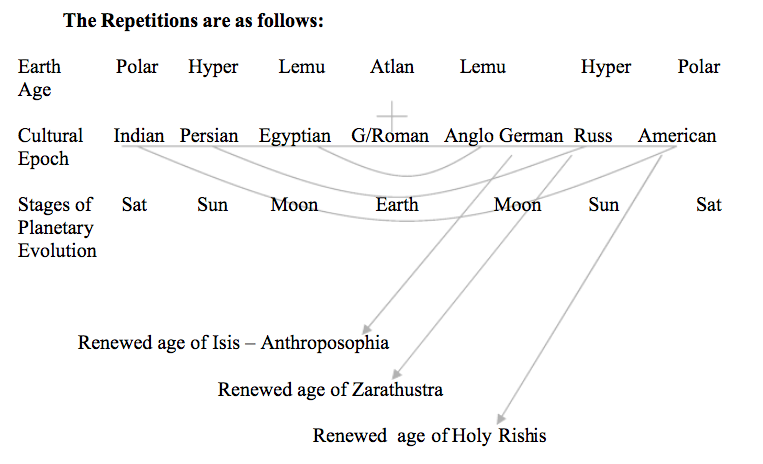
We can see then how important it is to know the past so that we can understand the present and foretell (to a certain degree) the future. Such insight can prepare us and enthuse us for the tasks that are ahead of us. It also serves to remind us that if we do not plant the seeds now, we cannot reap the harvest.
Notes:
[1] Rudolf Steiner Occult Science an Outline
[2] Rudolf Steiner Egyptian Myths and Mysteries
[3] Rudolf Steiner Occult Science – An Outline – Man and the Evolution of the world Part 6
[4] Rudolf Steiner Egyptian Myths and Legends
[5] Rudolf Steiner Egyptian Myths and Mysteries
[6] Rudolf Steiner Egyptian Myths and Mysteries see also Rudolf Steiner Occult Science an Outline Man and the Evolution of the Earth.
[7] Rudolf Steiner Preparing for the Sixth Epoch
[8] Ibid
[9] Rudolf Steiner Reading the Pictures of the Apocalypse
[10] Rudolf Steiner Cosmic Ego and Human Ego
[11] Rudolf Steiner Occult Science An Outline